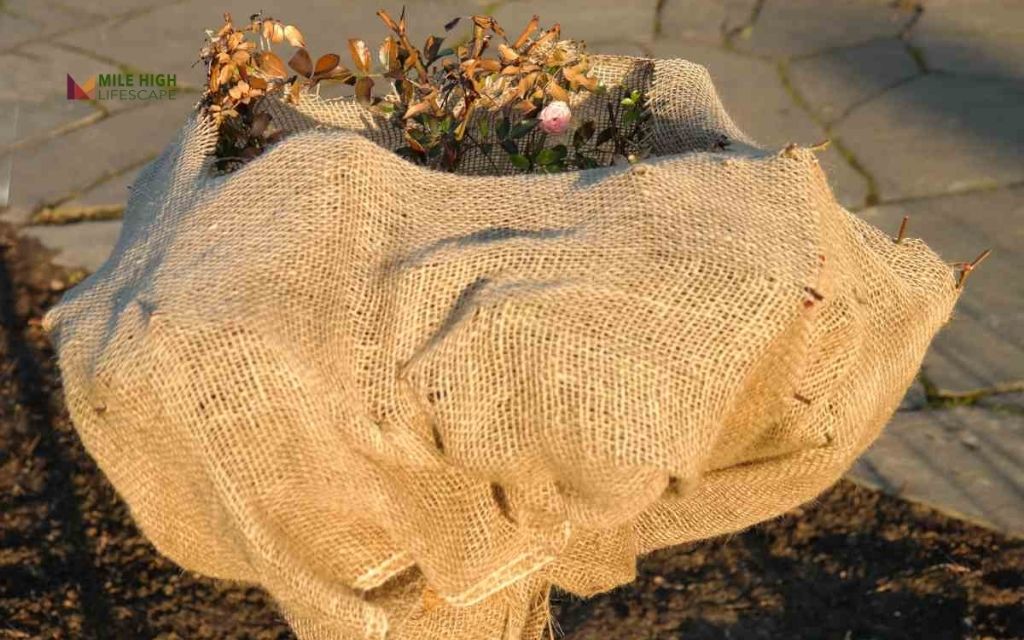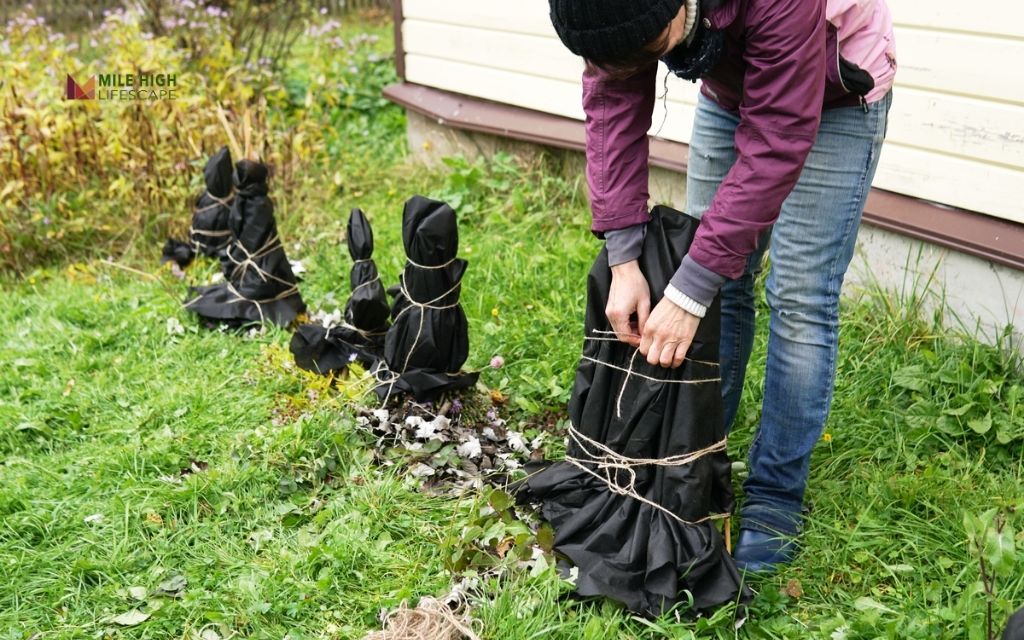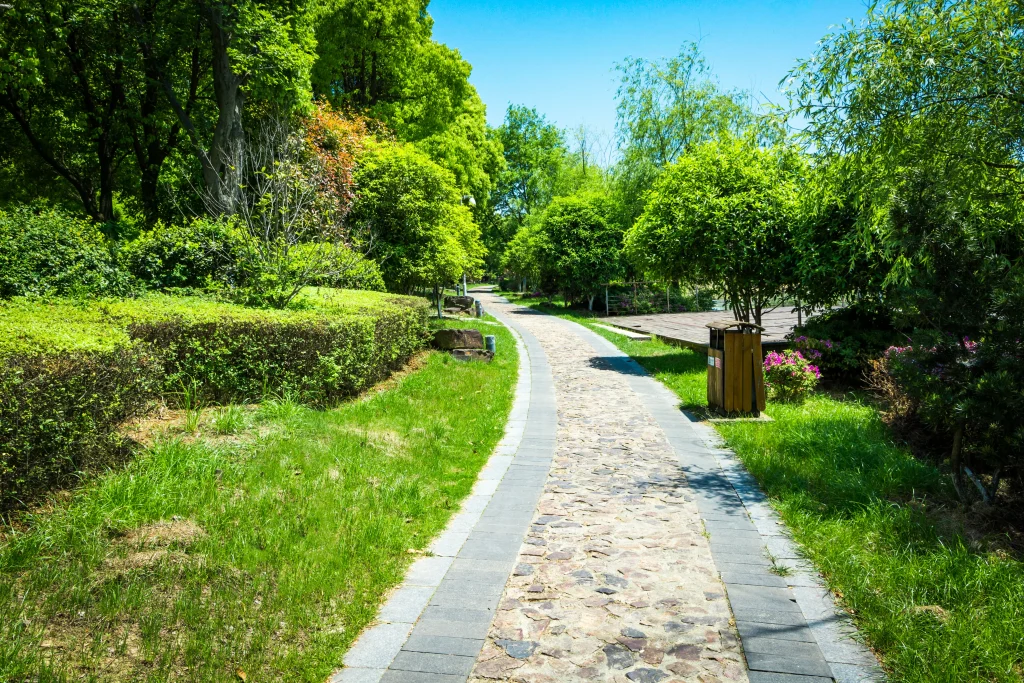How to winterize plants? To winterize plants, begin by watering deeply before the ground freezes, apply 2–4 inches of mulch to insulate roots, and protect vulnerable plants with burlap or frost cloth. Move potted plants indoors or wrap their containers. Avoid pruning most plants in fall and continue occasional winter watering. These steps help plants survive freezing temperatures, dry air, and sudden weather shifts.
What supplies do you need to winterize plants?
Get your winterization toolkit ready before Denver’s first frost hits. Here’s your essential shopping list:
Mulching essentials
- Best choices: Shredded bark, pine needles, or straw
- Application depth: 3-4 inches around plants
- What to avoid: Rock mulch (provides zero insulation!)
Protection materials
| Material | Primary Use | Best Application |
| Burlap | Wind/sun barrier | Evergreens, young trees |
| Frost cloth | Temperature protection | Perennials, tender plants |
| Plant stakes | Support system | All wrapped specimens |
Watering equipment
Essential tools for winter hydration:
- Soaker hose for deep, efficient watering
- Watering wand for hard-to-reach areas
- Freeze-resistant garden hose
Container storage solutions
Indoor options:
- Heated garage or basement space
- Large storage bins for smaller pots
Outdoor alternatives:
- Insulated plant wraps
- Protected patio areas
- Plant dollies for easy transport
How to winterize plants: Step-by-step process
Follow this systematic approach to protect your Denver landscape from harsh winter conditions:
Step 1: Clean up debris
Remove diseased foliage and dead plant material, but leave healthy ornamental grass seed heads for winter interest
Step 2: Apply mulch properly
Spread 2-4 inches of shredded bark or pine needles around plants, keeping 3-6 inches away from stems
Step 3: Water deeply before freeze
Ensure soil moisture reaches 12-18 inches deep; continue watering on warm winter days above 40°F
Step 4: Spray evergreens
Apply anti-desiccant coating on calm days above 40°F to prevent moisture loss through needles
Step 5: Wrap vulnerable plants
Use burlap for young trees and frost cloth for tender perennials, focusing protection on southwest-facing sides
Step 6: Prune selectively
Remove only broken or diseased branches; save major pruning for late winter to avoid stimulating new growth
Pro Tip: Use 3–4 inches of shredded bark or pine needles for insulation — skip rock mulch for winter protection! Rock mulch provides no insulation and can actually increase temperature fluctuations around plant roots.

Why is it important to winterize your plants in Denver?
Denver’s semi-arid, high-altitude climate creates multiple stress factors that can kill unprotected plants. Temperature swings of 40-50°F in a single day cause premature dormancy breaks, while constant dry air and intense UV radiation desiccate even drought-tolerant species.
Without protection, plants face:
- Root freezing in shallow soil or containers
- “Winter burn” on evergreens from moisture loss
- Bark splitting from temperature extremes
- Complete plant loss, especially non-native species
Protected plants maintain healthier root systems, recover faster in spring, and develop better long-term resilience to Colorado’s challenging conditions.
When is the best time to winterize gardens in Denver?
Denver frost calendar
| Event | Typical Date | Range |
| First frost | October 15 | Sept 15 – Oct 31 |
| Last frost | April 30 | April 15 – May 15 |
Critical timing factors
- Why early prep matters: Unexpected cold snaps can arrive ahead of schedule
- Late fall risk: Warm spells trick plants into breaking dormancy prematurely
- Solution: Monitor forecasts and prepare materials in advance
Your winterization timeline
Late september
- Gather protection materials
- Start moving tender containers indoors
Early october
- Apply anti-desiccant sprays
- Begin deep watering routine
Mid-october
- Install wraps and covers
- Apply mulch layers
Late october/november
- Complete final deep watering
- Finish all protection measures
Winter months
- Monitor during warm spells
- Provide supplemental water when possible
Remember: Flexibility beats rigid scheduling – adjust based on actual weather conditions each year.

Which types of plants need protection during winter?
Understanding plant vulnerability helps prioritize protection efforts and allocate resources effectively.
Annuals vs. perennials vs. biennials
Annual flowers and vegetables complete their life cycle in one growing season and won’t survive winter regardless of protection. However, some “annuals” like geraniums and begonias are actually tender perennials that can be overwintered indoors.
True perennials are designed to survive winter, but their hardiness varies significantly. Even cold-hardy perennials may need protection during establishment or extreme weather events. Biennials like hollyhocks and foxgloves require protection to complete their two-year life cycles.
Evergreen vs. deciduous plants:
Evergreen shrubs and trees face unique winter challenges since they retain foliage that continues losing moisture throughout winter. Broad-leafed evergreens like rhododendrons and holly are particularly vulnerable to desiccation and need consistent protection.
Deciduous plants enter dormancy by dropping leaves, reducing winter stress. However, young deciduous trees and shrubs still need protection from bark splitting and root freezing.
Container plant vulnerability:
Potted plants face extreme risk since container roots are exposed to air temperatures rather than being insulated by earth. Even hardy plants in containers may not survive Denver winters without moving to protected locations or providing insulation.
Common Denver plants and winter needs:
Russian sage typically survives Denver winters but benefits from leaving seed heads for insulation. Cut back in late winter rather than fall.
Lavender varieties differ significantly in cold tolerance. English lavender usually survives with protection, while French and Spanish types often require indoor overwintering.
Ornamental grasses like fountain grass and maiden grass provide winter interest and natural insulation when left standing. Cut back in late winter before new growth emerges.
Roses vary by type, with shrub roses generally hardier than hybrid teas. All benefit from mulching and avoiding fall pruning.
Conclusion
Winterizing your plants in Denver isn’t optional—it’s essential for surviving the region’s harsh, unpredictable winters. Denver’s extreme temperature swings, dry air, and intense sun create conditions that can devastate unprotected landscapes.
Proper winterization protects your investment and ensures healthy spring regrowth. Whether you DIY or work with professionals like Mile High Lifescape, taking action before harsh weather arrives saves both plants and money.
Every hour spent on fall protection prevents multiple hours of spring restoration work and costly plant replacements. Winter preparation is your key to year-round garden success in Colorado’s challenging climate.
Frequently asked questions (FAQs)
Do I need to water my garden in winter?
Yes, winter watering is crucial in Denver’s dry climate. Water deeply before the ground freezes and continue supplemental watering on warm days (40°F+) when soil isn’t frozen. Evergreen plants especially need winter moisture since they continue losing water through their foliage.
What is the best mulch for winter protection in Colorado?
Shredded bark, pine needles, and composted leaves provide the best winter insulation for Colorado gardens. Apply 2-4 inches deep while keeping mulch away from plant stems. Avoid rock mulch, which provides no insulation and can increase temperature fluctuations.
Can I leave potted plants outside in winter?
Most potted plants cannot survive Denver winters outdoors since container roots are exposed to air temperatures. Move tender plants indoors or to protected areas like unheated garages. Hardy plants in large containers may survive with insulation wrapping, but moving them is safer.
What is the best way to cover plants from the cold?
Use breathable materials like burlap or frost cloth rather than plastic, which can trap moisture and cause rot. Support covers with stakes to prevent direct contact with foliage. Leave tops open for air circulation and remove covers during warm spells to prevent overheating.
How to save a plant that got too cold?
Don’t prune freeze-damaged plants immediately! Wait until spring to assess actual damage. Keep soil slightly moist but not waterlogged. Gradually move container plants to warmer locations rather than shocking them with sudden temperature changes. Many plants recover from cold damage better than expected if given time and proper care.
